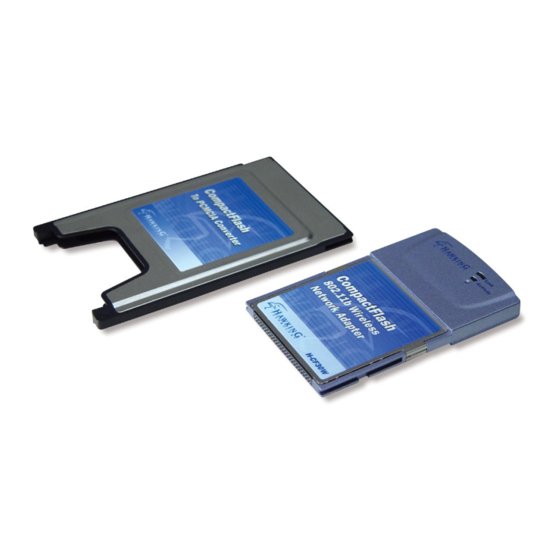
Advertisement
Quick Links
Advertisement

Summary of Contents for Hawking H-CF30W
- Page 1 H-CF30W CompactFlash 802.11b WLAN Card...
-
Page 2: Limited Warranty
(2) years from the date of purchase. If the product proves defective during this two-year warranty period, call Hawking Customer Service in order to obtain a Return Authorization number. Warranty is for repair or replacement only. -
Page 3: Regulatory Statements
REGULATORY STATEMENTS FCC Certification The United States Federal Communication Commission (FCC) and the Canadian Department of Communications have established certain rules governing the use of electronic equipment. Part15, Class B This device complies with Part 15 of FCC rules. Operation is subject to the following two conditions: 1) This device may not cause harmful interface, and 2) This device must accept any interface received, including... - Page 4 Connect your PDA to your PC. Make sure you have the Microsoft ActiveSync Utility installed on your PC to make an active connection. Caution: DO NOT insert the Wireless CompactFlash Card into the PDA BEFORE installing the configuration utility. 1. Insert the device driver CD into the CD-ROM drive.
- Page 5 4. Click Next to continue. 5. Click OK. 6. Click Finish.
- Page 6 7. You insert Wireless CompactFlash Card into your PDA. Then use the Settings on your Windows CE to configure the network settings.
- Page 7 1. Plug the Wireless CF card into the PCMCIA Adapter. The Wireless CF card is then turned into a conventional PCMCIA type II PC Card. 2. Align the PC Card toward the PC Card slot with the Hawking label facing upward, as shown below.
- Page 8 Install your Wireless CF card into the PCMCIA converter and place the install CD-ROM into your notebook’s CD-ROM drive. Then place the CF card with converter into your notebook’s PCMCIA slot and Windows will ask you for the location of the software driver. Please make sure to have windows search your CD-Rom drive to install the wireless navigator software.
- Page 9 Once the driver has been installed, you must make some changes to your network settings. Go to Start Click on Network Adapters. Highlight PRISM 11Mbps Wireless LAN Adapter, click Properties. Settings Connections.
- Page 10 Use server-assigned IP address If your network supports DHCP, select Use server-assigned IP address. The IP address and other information will be automatically assigned. Then click ok.
- Page 11 Use server-assigned IP address If your network does not support DHCP, select Use specific IP address. You may need to enter the IP address and other information. entering settings, click OK. If you forget to click OK, your settings will not take effect! 4.
- Page 12 After installing H-CF30W Wireless CompactFlash Card’s driver successfully, go to Start Programs. Click on PRISM Settings, the Network Status icon will appear in the task bar. 10 -...
-
Page 13: Network Status Icon & Icon Menu
Network Status Icon & Icon Menu The Status Icon Icon Green indicates a strong link. Yellow indicates a weak link. Red indicates no or a very poor link. Icon Menu After clicking on the icon, the icon menu as displayed below will prompt you to configure the H-CF30W Wireless CompactFlash Card. - Page 14 Items Wireless Radio On Wireless Radio Off Remove Status Icon… Removes the Utility icon Wireless Network Status Advanced Configuration… WEP Encryption… Version Information… All settings are categorized into 5 tabs: Link Configuration Encryption Site Survey About Link The Link tab displays the status of the H-CF30W.
- Page 15 Item State Current Channel Enable Radio / Disable Radio Rescan Current Tx Rate Throughput Description It displays the connection state of the Wireless CompactFlash Card with the wireless network. It displays the selected channel that is currently used. (There are 14 channels available, depends on the country.) Click this button to enable/disable...
- Page 16 Item Link Quality Signal Strength It displays the signal strength of Configuration The Configuration tab allows you to set parameters for the Wireless CompactFlash Card. Description It displays the link quality of the connection between the Wireless CompactFlash Card Access Point or Peer-to-Peer type it connects.
- Page 17 Item Description Saves values for all previous setting Profile parameters. contain the parameters configured at Name installation. Once the demands for switching between environments are met, you can set the additional profiles to reduce the configuration time. current parameters, highlight the Profile field, type a new name, and click on the Apply button.
- Page 18 Encryption WEP (Wired Equivalent Privacy) encryption can be used to ensure the security of your wireless network. Item Encryption (WEP) Create Keys with Passphrase Create Keys Manually Description WEP is a data privacy mechanism based on a 64-bit/128-bit shared key algorithm. Under the drop-down box, you choose encryption Disabled, 64 bit, or...
- Page 19 Alphanumeric: 5 characters Hexadecimal: 10 digits (0-9, A-F) Key 1: Key 2: Key 3: Key 4: Use WEP Key Apply You must use the same value/phrase and WEP key settings for all wireless computers in order for the wireless network to function properly. Click Alphanumeric if you are using an alphanumeric phrase.
-
Page 20: Site Survey
Site Survey The Site Survey tab shows all the available Access Points or Peer-to-Peer types and their features. Item Description Network The name must be identical for all Name devices and points attempting to connect to the same network. BSSID A set of wireless stations is referred to as a Basic Service Set (BSS). - Page 21 Item Encryption Signal Level Rescan Connect About The About tab shows the version information of the Configuration Utility. Description It displays the status of WEP Encryption. It displays the signal strength of the connection between the Wireless CompactFlash Card and the Access Point it connects.









